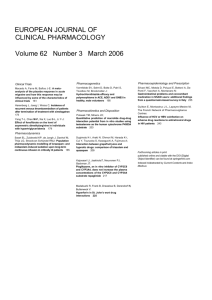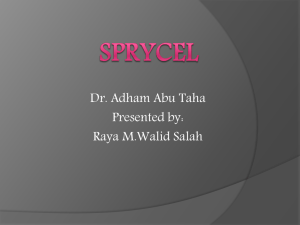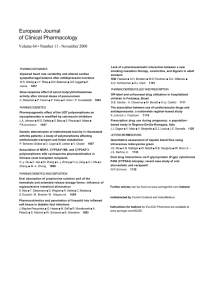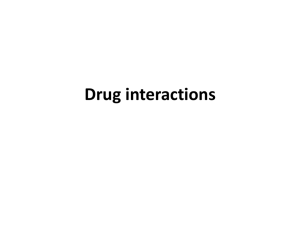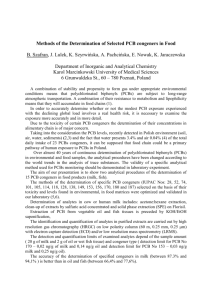Grandjean polychlorinated 2007
advertisement
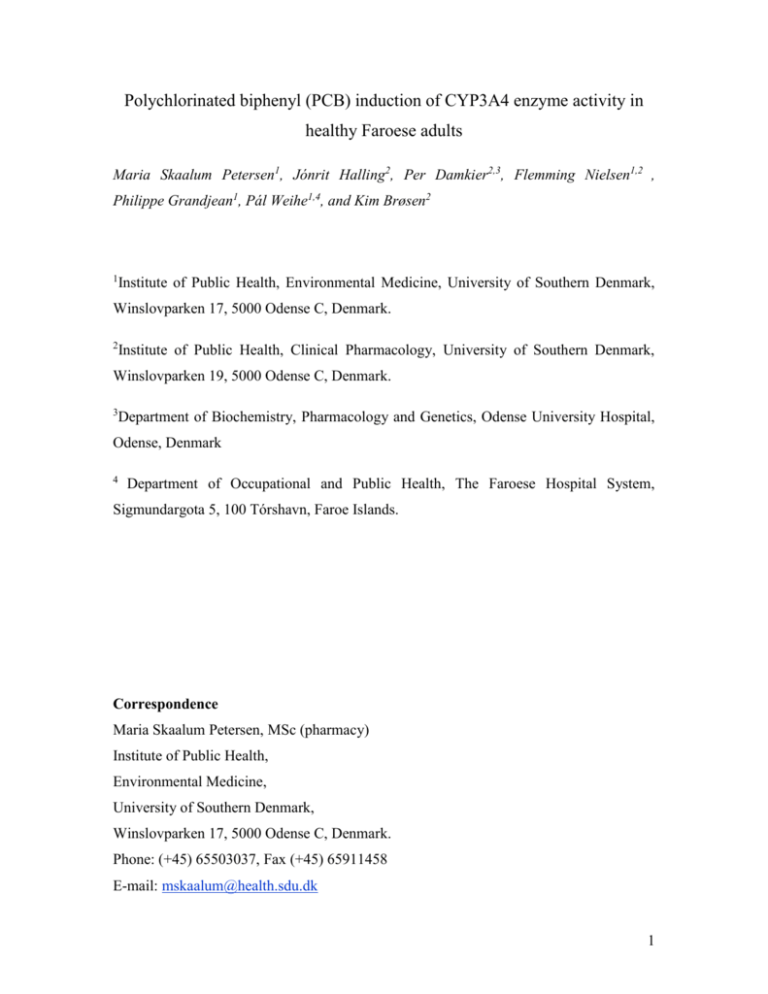
Polychlorinated biphenyl (PCB) induction of CYP3A4 enzyme activity in healthy Faroese adults Maria Skaalum Petersen1, Jónrit Halling2, Per Damkier2,3, Flemming Nielsen1,2 , Philippe Grandjean1, Pál Weihe1,4, and Kim Brøsen2 1 Institute of Public Health, Environmental Medicine, University of Southern Denmark, Winslovparken 17, 5000 Odense C, Denmark. 2 Institute of Public Health, Clinical Pharmacology, University of Southern Denmark, Winslovparken 19, 5000 Odense C, Denmark. 3 Department of Biochemistry, Pharmacology and Genetics, Odense University Hospital, Odense, Denmark 4 Department of Occupational and Public Health, The Faroese Hospital System, Sigmundargota 5, 100 Tórshavn, Faroe Islands. Correspondence Maria Skaalum Petersen, MSc (pharmacy) Institute of Public Health, Environmental Medicine, University of Southern Denmark, Winslovparken 17, 5000 Odense C, Denmark. Phone: (+45) 65503037, Fax (+45) 65911458 E-mail: mskaalum@health.sdu.dk 1 Abstract The CYP3A4 enzyme is, along with other cytochrome P450 enzymes, involved in the metabolism of environmental pollutants and is highly inducible by these substances. A commercial polychlorinated biphenyl (PCB) 1,1,1,-trichloro-2-(o- mixture, chlorophenyl), 2-(p’-chlorophenyl)ethane (o,p’-DDT) and 1,1,-dichloro-2,2-bis (pchlorophenyl)ethene (p,p’-DDE) are known to induce CYP3A4 activity through activation of nuclear receptors, such as the pregnane X receptor. However, this induction of CYP3A4 has yet not been investigated in humans. Thus, the aim of the study was to determine the variability of the CYP3A4 phenotype in regard to increased concentrations of polychlorinated biphenyls (PCBs) and other persistent organohalogen pollutants (POPs) in healthy Faroese adults. In 310 randomly selected Faroese residents aged 18-60 years, the CYP3A4 activity was determined based on the urinary 6- hydroxycortisol/cortisol (6-OHC/FC) ratio. POP exposures were assessed by measuring their concentrations in serum lipid. The results showed a unimodal distribution of the 6OHC/FC ratio with values ranging from 0.58 to 27.38. Women had a slightly higher 6OHC/FC ratio than men (p=0.07). Confounder-adjusted multiple regression analysis showed significant associations between 6-OHC/FC ratios and PCB, PCB-TEQ and p,p’-DDE, o,p’-DDT and HCB respectively, but the associations were statistically significant for men only. Keywords: CYP3A4, 6-hydroxycortisol/cortisol ratio, polychlorinated biphenyls, persistent organohalogen pollutants, Faroe Islands. 2 Introduction: The CYP3A4 enzyme is, along with other cytochrome P450 enzymes, involved in the metabolism of environmental pollutants and is highly inducible by these substances (Guengerich and Shimada, 1991; Nebert and Dalton, 2006). A commercial polychlorinated biphenyl (PCB) mixture (Okey, 1990; Lake et al., 1996), 1,1,1,-trichloro2-(o-chlorophenyl), 2-(p’-chlorophenyl)ethane (o,p’-DDT) and 1,1,-dichloro-2,2-bis (pchlorophenyl)ethene (p,p’-DDE) (Medina-Diaz et al., 2007) have been found to induce CYP3A4 activity through activation of nuclear receptors, such as the pregnane X receptor, thereby resulting in increased production of CYP3A4 mRNA and higher activity levels (Gibson et al., 2002; Harmsen et al., 2007; Medina-Diaz et al., 2007). However, this induction of CYP3A4 has yet not been investigated in humans. The residents of the Faroe Islands are exposed to elevated levels of PCBs and other environmental persistent organohalogen pollutants (POPs), e.g. DDT and DDE. The main source is traditional food, especially blubber from the pilot whale, which accumulates these pollutants (Bloch et al., 1990; Grandjean et al., 2001; Deutch and Hansen, 2003; Longnecker et al., 2003). Thus, with their wide range of exposures, the Faroese appear to be a highly appropriate population for studying a possible inductive effect of POPs on the CYP3A4 activity in humans. A high activity of another P450 enzyme, CYP1A2, was previously observed in the Faroese population (Petersen et al., 2006) but the distribution characteristics of the CYP3A4 phenotype in Faroese have yet not been described. In humans, CYP3A4 metabolizes over one-half of clinically used drugs (Zhou et al., 2004; Thummel and Wilkinson, 1998) and catalyzes the metabolism of a variety of exogenous and endogenous compounds (Shimada et al., 1989; Guengerich and Shimada, 1991; Shimida el al., 1994), including steroid hormones, such as testosterone, progesterone, and cortisol (Waxman et al., 1988; Harris et al., 1995). Significant interindividual variability in the expression and activity of CYP3A4 has been observed (Shimida el al., 1994; Wilkinson, 1996; Damkier and Brosen, 2000; Inagaki et al., 2002; Zhu et al., 2003), most likely a result of interplays of environmental, physiological and genetic factors (Gibson et al., 2002). CYP3A4 is involved in the 6-hydroxylation of cortisol, and both cortisol and its metabolites are excreted in the urine. Though not an ideal probe (Streetman et al., 2000), the ratio of urinary 6-hydroxycortisol (6-OHC) to 3 cortisol (FC) has long been used as a non-invasive indicator of the hepatic CYP3A4 activity (Park, 1981; Bienvenu et al., 1991; Watkins, 1994). We therefore applied this approach in this study to access the CYP3A4 activity in regard to the concentration of major PCBs and POPs . Materials and methods Subjects A total of 312 randomly selected healthy Faroese volunteers aged 18-60 years were recruited for the study. Detailed information on the recruitment has been previously described (Petersen et al., 2006). Despite the exclusion criteria of daily medication four participants were currently taking medication (other than oral contraceptives (OCs)) at the time of the examination, yet these four subjects were included, since the medications were known not to affect the CYP3A4 activity. Out of the 312 volunteers, two women were excluded from CYP3A4 analysis because of uncertain pregnancy status. Of the remaining 310 volunteers (141 women and 169 men), 128 (60 women and 68 men) were smokers. A total of 36 women used OCs and four were in postmenopausal hormone therapy. For the PCB and POP analyses, two subjects were excluded due to lack of blood sample or insufficient serum, and exposure results were therefore available from 143 women and 167 men. Data for both CYP3A4 activity and exposure were available from 308 subjects (141 women and 167 men). The Faroese Ethical Review Committee approved the protocol. Written informed consent was obtained from each volunteer on the basis of verbal and written information in Faroese. Experimental protocol Urine was collected from 0 h to 12 h, generally from the evening to next morning. The total volume was recorded, and two aliquots of 10 ml were stored. A 10 ml blood sample was drawn and centrifuged at 4000 g after a minimum of ½ hour to provide about 5 ml serum. Urine and serum samples were kept frozen at -80°C until analysis. A questionnaire was used to obtain information about smoking status, use of OCs and monthly consumption of pilot whale and blubber. 4 At the same occasion, measurements were conducted in regard to phenotypes for CYP2D6, CYP2C19 and CYP1A2 by combined administration of 100 mg sparteine, 100 mg mephenytoin and 200 mg caffeine (Halling et al., 2005; Petersen et al., 2006). These drugs are not known to affect the CYP3A4 activity. Analysis of the urine ratio of 6-OHC and FC Urine samples were prepared and the urinary 6-OHC and FC were analyzed by HPLC as previously described (Lykkesfeldt et al., 1994). The limit of quantification was 7.5 ng/ml for FC and 125 ng/ml for 6-OHC. The overall coefficient of variation was 10% for both compounds. Analysis of serum PCB and POPs The serum samples were analyzed for the major PCB congeners (PCB-101, PCB-105, PCB-118, PCB-138, PCB-153, PCB-156, PCB-180) and four other environmental POPs (o,p’-DDT, hexachlorobenzene (HCB), -hexachlorocyclohexane (-HCH) and p,p’DDE) by gas chromatography with electron-capture detection as described previously (Petersen et al., 2006). The results were adjusted for total serum lipid content and reported as μg per gram lipid. The median limit of detection was 0.03 ppb for all substances, which, at a mean lipid concentration of 10 g/l, corresponds to 0.003 μg/g lipid (Petersen et al., 2006). Data analysis The skewed distribution of the 6-OHC/FC ratio was normalized by logarithmic transformation; both mean ( S.D) and median are provided. Multiple linear regression analysis was used to examine the effect of potentially confounding variables (sex, age, smoking and OC use) on the CYP3A4 activity. The 6-OHC/FC ratios in men and women were compared by t-test, followed by gender-stratified regression analyses. Because PCB is a mixture of several congeners, the PCB was calculated as the sum of PCB138, PCB153 and PCB180 multiplied by 2, because the sum of these three major congeners represents close to 50% of the total PCB concentration in Faroese milk and serum (Grandjean et al., 1995). In addition, the estimated dioxin-like activity of the major 5 mono-ortho PCBs, expressed as TCDD equivalents (TEQs), was computed as the total for the three congeners PCB-105, PCB-118 and PCB-156 according to international guidelines (Ahlborg et al., 1994). Because of skewed distributions, the PCB and POP results were also log-transformed; non-detectable levels of PCB congeners and POPs were assumed to equal 0.001 μg/g lipid; this level corresponds to about one third of the detection limit. Multiple linear regression analyses were performed to examine the association of the log-transformed 6-OHC/FC ratio with log-transformed serum PCB, PCB-TEQ and POPs adjusted for the effect of potential confounding variables (sex, age, smoking and OC use). A 2 test was used to compare the consumption of whale blubber, indicative of PCB exposure, in men and women based on the questionnaire; the subjects were separated based on consumption “no more than once per month” and “at least two times per month” to obtain groups of approximately equal sizes. The serum concentrations of PCBs and POPs in men and women were compared by t-test. All two-sided p-values <0.10 were considered to be statistically significant. The statistical analysis was carried out by use of the SPSS program package, version 13.0. Results The 6-OHC/FC ratio showed a unimodal distribution with values ranging from 0.58 to 27.38 (figure 1). Women tended to have a higher 6-OHC/FC ratio than men (t-test, p=0.071) (Table 2 and 3). Among potential confounders, age (as dichotomous variable), smoking, and use of OCs, were not significant predictors of the 6-OHC/FC ratio in the gender-stratified multiple regression analysis (Table 3) and therefore only sex was included in the final model (Table 4). Table 1 shows the results of the analysis of PCBs and the other POPs. Confounderadjusted multiple regression analysis of log-transformed 6-OHC/FC ratio on logtransformed concentrations of serum PCB, PCB-TEQ, p,p’-DDE, o,p’-DDT and HCB respectively showed associations, but they were statistically significant only for men (Table 4). 6 The self-reported blubber consumption was significantly higher in men compared with women (2 test with df=1, p<0.0001). As blubber consumption is indicative of PCB exposure, the higher blubber consumption in men is in agreement with their higher serum-PCBs and POPs as seen in table 1 (Petersen et al., 2006). Men had significantly higher serum concentrations for all congeners and POPs (t-test, p<0.0001) except for -HCH where no difference was apparent (t-test, p=0.56). Discussion This study is the first to determine the distribution characteristics of the CYP3A4 phenotype in the Faroese. As anticipated, the 6-OHC/FC ratio showed a unimodal distribution. In addition, slightly elevated urinary 6-OHC/FC ratios were found in women compared with men (Table 3). This finding is in accordance with some studies (Hunt et al., 1992; Inagaki et al. 2002; Galteau and Shamsa, 2003; Zhu et al., 2003), while other reports suggest the reverse situation with higher activity in men or no genderrelated effect on CYP3A activity (Nakamura and Yakata, 1985; Galteau and Shamsa, 2003; El Desoky et al., 2005). The higher activity in women suggests a direct genderspecific increase in the amount of CYP3A protein resulting in enhanced CYP3A activity in women (Hunt et al., 1992), probably due to the fact that steroid hormones may regulate the CYP3A activity at the level of gene expression (Zhu et al. 2003). The wide interindividual variability of the CYP3A4 activity is in agreement with previous studies (Wilkinson, 1996; Thummel and Wilkinson, 1998; Inagaki et al., 2002; Zhu et al., 2003). It may be a consequence of genetic and non-genetic factors, including foods, demographic or environmental factors. Although variability in the CYP3A4 gene is not indicated by the data, the Faroese population shows some differences from other Caucasian populations (Schwartz et al., 1995; Hjalgrim et al., 1998; Santer et al., 2001; Milman et al., 2004; Halling et al., 2005), presumably due to founder effects, isolation, inbreeding or, perhaps, genetic drift. With respect to environmental factors, the Faroese are highly exposed to PCBs and some POPs due to the tradition of consuming of pilot blubber. The exposures vary widely, because some Faroese eat very little traditional food, while others eat large quantities. 7 A significant inductive effect of serum ΣPCB, PCB-TEQ, o,p’-DDT and HCB was suggested by the urinary 6-OHC/FC ratio, but stratified analysis revealed that the effect was due to an association in men, but not women. The positive association observed between the CYP3A4 activity and ΣPCB, calculated based on the di-ortho congeners, and PCB-TEQ, calculated for three mono-ortho congeners, is consistent with previous observations that mono- and di-ortho congeners constitute two structural classes of PCBs that exhibit “phenobarbital like” induction activity which are known to induce CYP3A isoenzymes (Okey, 1990; Safe, 1994). However, the colinearity between PCB congeners makes it difficult to separate possible effects of different classes of PCBs. The significant induction on CYP3A4 activity seen for o,p’-DDT and p,p’-DDE in men is also in agreement with previous observations (Medina-Diaz et al., 2007), whereas HCB has not formerly been linked to CYP3A4 induction. Again, an independent effect of HCB is difficult to document in an observational study like this, where exposures are correlated. In the Faroese subjects examined, men had a higher POP exposure than women, so enzyme induction by these food contaminants would tend to minimize a sex difference in CYP3A4 expression. A question may then be raised, why the induction only is apparent among men and not women. One possible explanation could be that female hormones have stronger enhancing effect on the CY3A4 activity than the PCBs and POPs and thereby mask the effect of these pollutants on the CYP3A4 activity among women. The lower blubber intake and serum concentrations of PCBs in women compared with men may be of importance as well. Thus, a threshold effect may exist for PCB or POP induction, such that the inductive effect of PCBs or POPs is only apparent if the concentration is above a certain limit, might be a possible explanation. This hypothesis is not supported by any evidence so far, since this study, to our knowledge, is the first to investigate the possible inductive effect of PCBs and POPs on the CYP3A4 activity in humans. The 6-OHC/FC ratio is not regarded as a precise index of the actual metabolic activity of CYP3A4 but nevertheless a useful measure of CYP3A induction (Streetman et al., 2000). The limitations of this parameter would not have any great impact on the strength of the conclusions of this study, which emphasizes the 8 possible induction of POPs on the 6-OHC/FC ratio and not the actual CYP3A4 activity. As the Faroese are highly exposed to certain POPs, which may induce CYP3A4 activity in experimental studies, attention should be paid to the possible disruption of the endocrine homeostasis, since CYP3A4 catalyzes the 6-hydroxylation of a number of steroids (Waxman et al. 1988; Harris et al., 1995). Further, altered dose efficacy of drugs metabolized by CYP3A4, resulting in either toxicity or therapeutic failure, could be a consequence of this potential induction and would warrant attention. In conclusion, the 6-OHC/FC ratio, reflecting the CYP3A4 activity, was unimodally distributed and showed a wide interindividual variation. Statistically significant association between 6-OHC/FC ratios and serum PCB, PCB-TEQ, p,p’-DDE, o,p’DDT and HCB respectively were found, although for men only. Further studies are needed to replicate the inductive effect of PCBs and POPs on the CYP3A4 activity in humans and the possible sex-related difference in enzyme induction. Acknowledgements This study was supported by “Apotekerfonden af 1991”. The assistance of the staff at the Department of Occupational and Public Health in Tórshavn, Faroe Islands is highly appreciated. 9 References Ahlborg, U.G., Becking, G.C., Birnbaum, L.S., Brouwer, A., Derks, H.J.G.M., Feeley, M., Golor, G., Hanberg, A., Larsen, J.C., Liem, A.K.D., Safe, S.H., Schlatter, C., Waern, F., Younes, M., Yrjanheikki, E., 1994. Toxic equivalency factors for dioxin-like PCBs. Chemosphere 28, 1049-1067. Bienvenu, T., Rey, E., Pons, G., d'Athis, P., Olive, G., 1991. A simple non-invasive procedure for the investigation of cytochrome P-450 IIIA dependent enzymes in humans. Int. J. Clin. Pharmacol. Ther. Toxicol. 29, 441-445. Bloch, D., Desportes, G., Hoydal, K., Jean, P., 1990. Pilot whaling in the Faroe Islands, July 1986–July 1988. North Atlantic Studies 2, 36–44. Damkier, P., Brosen, K., 2000. Quinidine as a probe for CYP3A4 activity: intrasubject variability and lack of correlation with probe-based assays for CYP1A2, CYP2C9, CYP2C19, and CYP2D6. Clin. Pharmacol. Ther. 68, 199-209. Deutch, B., Hansen, J.C. (Eds), 2003. AMAP Greenland and the Faroe Islands 1997– 2001. Danish Environmental Protection Agency, Copenhagen. El Desoky, E.S., Mohamed, H.O., Farghaly, W.M., Hamed, S.A., Hedaya, M.A., Siest, J.P., 2005. Study of urinary 6 beta-hydroxycortisol/cortisol ratio in spot urine sample as a biomarker of 3A4 enzyme activity in healthy and epileptic subjects of Egyptian population. Pharmacol. Res. 51, 575-580. Galteau, M.M., Shamsa, F., 2003. Urinary 6beta-hydroxycortisol: a validated test for evaluating drug induction or drug inhibition mediated through CYP3A in humans and in animals. Eur. J. Clin. Pharmacol. 59, 713-733. Gibson, GG., Plant, NJ., Swales, KE., Ayrton, A., El-Sankary, W., 2002. Receptordependent transcriptional activation of cytochrome P4503A genes: induction mechanisms, species differences and interindividual variation in man. Xenobiotica. 32, 165-206. Grandjean, P., Weihe, P., Needham, L.L., Burse, V.W., Patterson, D.G. Jr., Sampson, E.J., Jørgensen, P.J., Vahter, M., 1995. Effect of a seafood diet on mercury, selenium, arsenic, and PCBs and other organochlorines in human milk. Environ. Res. 71, 29-38. Grandjean. P., Weihe, P., Burse, V.W., Needham, L.L., Storr-Hansen, E., Heinzow, B., Debes, F., Murata, K., Simonsen, H., Ellefsen, P., Budtz-Jorgensen, E., Keiding, N., White, R.F., 2001. Neurobehavioral deficits associated with PCB in 7-year-old children prenatally exposed to seafood neurotoxicants. Neurotoxicol. Teratol. 23, 305–317. 10 Guengerich, F.P., Shimada, T., 1991. Oxidation of toxic and carcinogenic chemicals by human cytochrome P-450 enzymes. Chem. Res. Toxicol. 4, 391-407. Halling, J., Petersen, M.S., Damkier, P., Nielsen, F., Grandjean, P., Weihe, P., Lundgren, S., Lundblad, M.S., Brosen, K., 2005. Polymorphism of CYP2D6, CYP2C19, CYP2C9 and CYP2C8 in the Faroese population. Eur. J. Clin. Pharmacol. 61, 491–497. Harmsen, S., Meijerman, I., Beijnen, JH., Schellens, JH., 2007. The role of nuclear receptors in pharmacokinetic drug–drug interactions in oncology. Cancer. Treat. Rev. doi:10.1016/j.ctrv.2007.02.003 Harris, R.Z., Benet, L.Z., Schwartz, J.B., 1995. Gender effects in pharmacokinetics and pharmacodynamics. Drugs. 50, 222–239. Hjalgrim, H., Tulinius, H., Dalberg, J., Hardarson, S., Frisch, M., Melbye, M., 1998. High incidence of classical Kaposi's sarcoma in Iceland and the Faroe Islands. Br. J. Cancer. 77, 1190-1193. Hunt, C.M., Westerkam, W.R., Stave, G.M., 1992. Effect of age and gender on the activity of human hepatic CYP3A. Biochem. Pharmacol. 44, 275-283. Inagaki, K., Inagaki, M., Kataoka, T., Sekido, I., Gill, MA., Nishida, M., 2002. A wide inter-individual variability of urinary 6-hydroxycortisol to free cortisol in 487 healthy Japanese subjects in near basal condition. Ther. Drug. Monit. 24, 722-727. Lake, B.G,, Charzat, C., Tredger, J.M., Renwick, A.B., Beamand, J.A., Price R.J., 1996. Induction of cythorome P450 isoenzymes in cultured precision-cut rat and human liver slices. Xenobiotica 26, 297-306. Longnecker, M.P., Wolff, M.S., Gladen, B.C., Brock, J.W., Grandjean, P., Jacobson, J.L., Korrick, S.A., Rogan, W.J., Weisglas-Kuperus, N., Hertz-Picciotto, I., Ayotte, P., Stewart, P., Winneke, G., Charles, M.J., Jacobson, S.W., Dewailly, E., Boersma, E.R., Altshul, L.M., Heinzow, B., Pagano, J.J., Jensen, A.A., 2003. Comparison of polychlorinated biphenyl (PCB) levels across studies of human neurodevelopment. Environ. Health. Perspect. 11, 165–70. Lykkesfeldt, J., Loft, S., Poulsen, H., 1994. Simultaneous determination of urinary free cortisol and 6-hydroxycortisol by high-performance liquid chromatography to measure human CYP3A activity. J. Chromatogr. B. Biomed. Appl. 660, 23-29. Medina-Diaz, IM., Arteaga-Illan, G., de Leon, MB., Cisneros, B., Sierra-Santoyo, A., Vega, L., Gonzalez, FJ., Elizondo, G., 2007. Pregnane X receptor-dependent induction of the CYP3A4 gene by o,p'-1,1,1,-trichloro-2,2-bis(p-chlorophenyl)ethane. Drug Metab. Dispos. 35, 95-102. 11 Milman, N., Steig, T., Koefoed, P., Pedersen, P., Fenger, K., Nielsen, F.C., 2004. Frequency of the hemochromatosis HFE mutations C282Y, H63D, and S65C in blood donors in the Faroe Islands. Ann. Hematol. 84, 146-149. Nakamura, J., Yakata, M., 1985. Age- and sex-related differences in urinary excretion of 6 beta-hydroxycortisol in humans. Clin. Chim. Acta. 152, 193-197. Nebert, D.W., Dalton, T.P., 2006. The role of cytochrome P450 enzymes in endogenous signalling pathways and environmental carcinogenesis. Nat. Rev. Cancer. 6, 947-960. Okey, A.B., 1990. Enzyme induction in the cytochrome P-450 system. Pharmacol. Ther. 45, 241-298. Park, B.K., 1981. Assessment of urinary 6-hydroxycortisol as an in vivo index of mixed-function oxygenase activity. Br. J. Clin. Pharmacol. 12, 97–102. Petersen, M.S., Halling, J., Damkier, P., Nielsen, F., Grandjean, P., Weihe, P., Brosen, K., 2006. Caffeine N3-demethylation (CYP1A2) in a population with an increased exposure to polychlorinated biphenyls. Eur. J. Clin. Pharmacol. 62, 10411048. Safe, S., 1994. Polychlorinated biphenyles (PCBs): environmental Impact, biochemical and toxic responses and implication for risk assessment. Critic. Review. Toxicol. 24, 87-149. Santer, R., Kinner, M., Steuerwald, U., Kjaergaard, S., Skovby, F., Simonsen, H., Shaiu, W-L., Chen, T-T., Schneppenheim, R., Schaub, J., 2001. Molecular genetic basis and prevalence of glycogen storage disease type IIIA in the Faroe Islands. Eur. J. Hum. Gen. 9, 388-391. Schwartz, M., Sorensen, N., Brandt, N.J., Hogdall, E., Holm, T., 1995. High incidence of cystic fibrosis on the Faroe Islands: a molecular and genealogical study. Hum. Genet. 95, 703-706. Shimada, T., Iwasaki, M., Martin, M.V., Guengerich F.P., 1989. Human liver microsomal cytochrome P-450 enzymes involved in the bioactivation of procarcinogens detected by umu gene response in Salmonella typhimurium TA 1535/pSK1002. Cancer Res. 49, 3218–3228. Wilkinson, G.R., 1996. Cytochrome P4503A (CYP3A) metabolism: prediction of in vivo activity in humans. J. Pharmacokinet. Biopharm. 24, 475-490. Shimida, T., Yamazaki, H., Mimura, M., Inui, Y., and Guengerich, F. P., 1994. Interindividual variations in human liver cytochrome P450 enzymes involved in the 12 oxidation of drugs, carcinogens and toxic chemicals: studies with liver microsomes of 30 Japanese and 30 Caucasians. J. Pharmacol. Exp. Ther. 270, 414–423. Streetman, D.S., Bertino, J.S.Jr., Nafziger, A.N., 2000. Phenotyping of drugmetabolizing enzymes in adults: a review of in-vivo cytochrome P450 phenotyping probes. Pharmacogenetics. 10, 187-216. Thummel, K.E., Wilkinson, G. R., 1998. In vitro and in vivo drug interactions involving human CYP3A. Annu. Rev. Pharmacol. Toxicol. 38, 389-430. Watkins, P.B., 1994. Noninvasive tests of CYP3A enzymes. Pharmacogenetics 4, 171–84. Waxman, D.J., Attisano, C., Guengerich, F.P., Lapenson, D.P., 1988. Human liver microsomal steroid metabolism: identification of the major microsomal steroid hormone 6-hydroxylase cytochrome P-450 enzyme. Arch. Biochem. Biophys. 263, 424–436. Zhou, S., Chan, E., Lim, L.Y., Boelsterli, U.A., Li, S.C., Wang, J., Zhang, Q., Huang, M., Xu, A., 2004. Therapeutic drugs that behave as mechanism-based inhibitors of cytochrome P450 3A4. Curr. Drug Metab. 5, 415-442. Zhu, B., Liu, Z.Q., Chen, G.L., Chen, X.P., Ou-Yang, D.S., Wang, L.S., Huang, S.L., Tan, Z.R., Zhou, H.H., 2003. The distribution and gender difference of CYP3A activity in Chinese subjects. Br. J. Clin. Pharmacol. 55, 264-269. 13 Table 1 Serum concentration (μg/g lipid) of polychlorinated biphenyles (PCBs) and persistent organohalogen pollutants (POPs) in 310 Faroese healthy subjects. Interquartile range Congener Geometric mean All subjects Men Women (25% - 75%) Total range All subjects All subjects n = 310 n = 310 n = 310 n = 167 n = 143 PCB-101 0.007 a 0.009* 0.005* 0.003-0.02 0.001-0.1 PCB-105 0.017 b 0.021* 0.013* 0.01-0.04 0.001-0.5 PCB-118 0.097 0.121* 0.075* 0.05-0.2 0.004-1.9 PCB-138 0.381 0.506* 0.274* 0.2-0.4 0.03-5.3 PCB-153 0.550 0.735* 0.392* 0.3-1.1 0.04-8.7 PCB-156 0.046 c 0.060* 0.033* 0.02-0.1 0.002-0.6 PCB-180 0.342 0.454* 0.246* 0.2-0.7 0.02-5.0 Total PCBs 1.468 1.949* 1.054* 0.7-2.9 0.1-21.8 PCBf 2.578 3.444* 1.838* 1.3-5.0 0.17-37.4 PCB-TEQg 3.515 4.545* 2.604* 1.6-7.1 0.18-54.5 p,p’-DDEh 1.182 1.578* 0.844* 0.5-2.6 0.04-17.7 HCBi 0.080 0.093* 0.066* 0.04-0.1 0.01-0.9 -HCHj 0.017d 0.016 0.017 0.01-0.03 0.001-0.09 o,p’-DDTk 0.096e 0.138* 0.063* 0.04-0.3 0.001-2.0 a 73 samples with level below the detection limit (<0.003 μg/g lipid) b c 29 samples with level below the detection limit (<0.003 μg/g lipid) 1 sample with level below the detection limit (<0.003 μg/g lipid) d 14 samples with level below the detection limit (<0.003 μg/g lipid) e 3 samples with level below the detection limit (<0.003 μg/g lipid) f PCB is calculated as 2.0 x PCB (138+153+180) g PCB-TEQ is calculated as ((PCB105 + PCB118 + 5*PCB156) *10). Unit: pg TEQ/g lipid h 1,1,-dichloro-2,2-bis (p-chlorophenyl)ethene i hexachlorobenzene -hexachlorocyclohexane j k 1,1,1,-trichloro-2-(o-chlorophenyl), 2-(p’-chlorophenyl)ethane *statistical significant (p<0.0001) 14 Table 2 The 6-hydroxycortisol/cortisol ratio (6-OHC/FC) in 12-h urine samples from men and women with and without current use of hormone supplements. Mean SD Total Men n = 310 n = 169 all OCa non-users OCa users n = 141 n = 40 n = 101 6.99 4.25 6.72 4.19 7.36 4.34 7.76 4.47 6.35 3.86 6.15 5.81 6.40 6.86 5.66 Median a Women oral contraceptives Table 3 Multiple regression analysis of log-transformed 6-hydroxycortisol/cortisol ratio (6-OHC/FC) on background variables in 308 healthy Faroese subjects. Total Women Men n = 308 n = 141 n = 167 p-value p-value p-value Sex (women/men) 0.053 0.071* - - - - Age (38 year/<38 year)a 0.055 0.062* 0.049 0.257 0.048 0.250 Smoker (yes/no) -0.007 0.804 -0.040 0.339 0.019 0.655 - - -0.068 0.159 - - Oral contraceptivesb (yes/no) a median age of subjects was 38 years b women only (40 users) *statistical significant (p<0.1) 15 Table 4 Confounder-adjusteda multiple regression analysis of log-transformed 6hydroxycortisol/cortisol ratio (6-OHC/FC) on log-transformed serum concentration in 308 healthy Faroese subjects. Total Men Women n = 308 n = 167 n = 141 All women OCb non- OCb users n = 141 users n = 101 n = 40 p- value PCBc value p- value p- value pvalue 0.063* 0.093 0.054* 0.027 0.616 -0.101 0.310 0.046 0.487 PCB-TEQd 0.067 0.048* 0.095 0.036* 0.023 0.665 -0.077 0.418 0.035 0.590 p,p’-DDEe 0.045 0.130 0.073 0.081* 0.011 0.806 -0.094 0.241 0.024 0.651 HCBf 0.103 0.019* 0.137 0.020* 0.050 0.458 -0.081 0.512 0.068 0.409 -HCHg 0.009 0.818 0.050 0.347 -0.052 0.378 -0.021 0.874 -0.079 0.233 o,p’-DDTh 0.046 0.080* 0.065 0.069* 0.018 0.662 -0.057 0.441 0.026 0.605 a Adjusted for sex (p=0.02) b c f oral contraceptives PCB is calculated as 2.0 x PCB (138+153+180) d e 0.067 p- PCB-TEQ is calculated as ((PCB105 + PCB118 + 5*PCB156) *10 1,1,-dichloro-2,2-bis (p-chlorophenyl)ethene hexachlorobenzene -hexachlorocyclohexane g h 1,1,1,-trichloro-2-(o-chlorophenyl), 2-(p’-chlorophenyl)ethane *statistical significant (p<0.1) 16 Figure 1 Log-transformed distribution of the urinary 6-hydroxycortisol/cortisol (6OHC/FC) ratio reflecting CYP3A4 activity in 310 Faroese healthy subjects. 50 Frequency 40 30 20 10 0 -0.50 0.00 0.50 1.00 1.50 logCYP3A4 17
